Star Swarm, DirectX 12 AMD APU Performance Preview
by Ryan Smith & Ian Cutress on February 13, 2015 10:00 AM EST- Posted in
- GPUs
- AMD
- Microsoft
- APUs
- DirectX 12

After several requests and a week’s break from our initial DirectX 12 article, we’re back again with an investigation into Star Swarm DirectX 12 performance scaling on AMD APUs. As our initial article was run on various Intel CPU configurations, this time we’re going to take a look at how performance scales on AMD’s Kaveri APUs, including whether DX12 is much help for the iGPU, and if it can help equalize the single-threaded performance gap been Kaveri and Intel’s Core i3 family.
To keep things simple, this time we’re running everything on either the iGPU or a GeForce GTX 770. Last week we saw how quickly the GPU becomes the bottleneck under Star Swarm when using the DirectX 12 rendering path, and how difficult it is to shift that back to the CPU. And as a reminder, this is an early driver on an early OS running an early DirectX 12 application, so everything here is subject to change.
| CPU: | AMD A10-7800 AMD A8-7600 Intel i3-4330 |
| Motherboard: | GIGABYTE F2A88X-UP4 for AMD ASUS Maximus VII Impact for Intel |
| Power Supply: | Rosewill Silent Night 500W Platinum |
| Hard Disk: | OCZ Vertex 3 256GB OS SSD |
| Memory: | G.Skill 2x4GB DDR3-2133 9-11-10 for AMD G.Skill 2x4GB DDR3-1866 9-10-9 at 1600 for Intel |
| Video Cards: | MSI GTX 770 Lightning AMD APU iGPU |
| Video Drivers: | NVIDIA Release 349.56 Beta AMD Catalyst 15.200 Beta |
| OS: | Windows 10 Technical Preview 2 (Build 9926) |
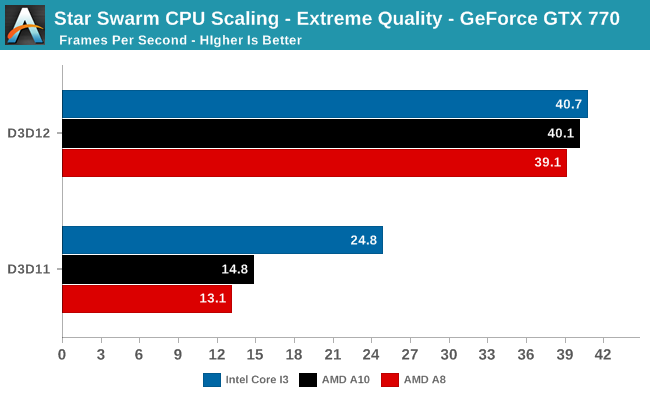
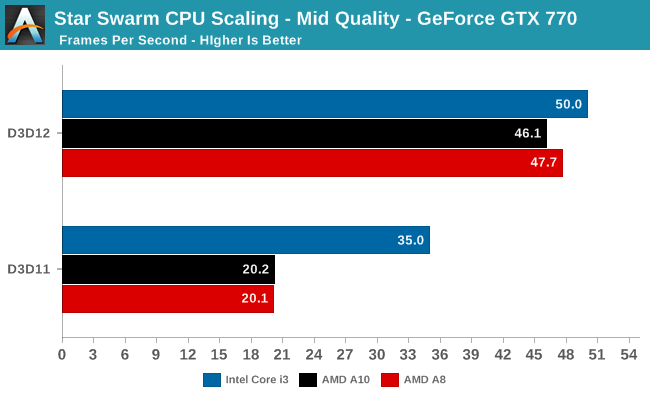
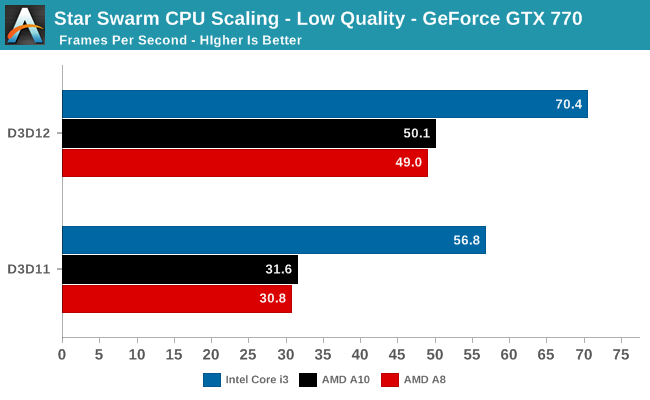
To get right down to business then, are AMD’s APUs able to shift the performance bottleneck on to the GPU under DirectX 12? The short answer is yes. Highlighting just how bad the single-threaded performance disparity between Intel and AMD can be under DirectX 11, what is a clear 50%+ lead for the Core i3 with Extreme and Mid qualities becomes a dead heat as all 3 CPUs are able to keep the GPU fully fed. DirectX 12 provides just the kick that the AMD APU setups need to overcome DirectX 11’s CPU submission bottleneck and push it on to the GPU. Consequently at Extreme quality we see a 64% performance increase for the Core i3, but a 170%+ performance increase for the AMD APUs.
The one exception to this is Low quality mode, where the Core i3 retains its lead. Though initially unexpected, examining the batch count differences between Low and Mid qualities gives us a solid explanation as to what’s going on: low pushes relatively few batches. With Extreme quality pushing average batch counts of 90K and Mid pushing 55K, average batch counts under Low are only 20K. With this relatively low batch count the benefits of DirectX 12 are still present but diminished, leading to the CPU no longer choking on batch submission and the bottleneck shifting elsewhere (likely the simulation itself).
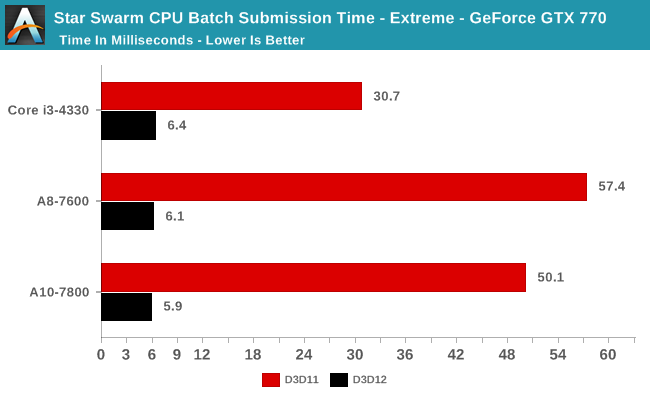
Meanwhile batch submission times are consistent between all 3 CPUs, with everyone dropping down from 30ms+ to around 6ms. The fact that AMD no longer lags Intel in batch submission times at this point is very important for AMD, as it means they’re not struggling with individual thread performance nearly as much under DirectX 12 as they were DirectX 11.
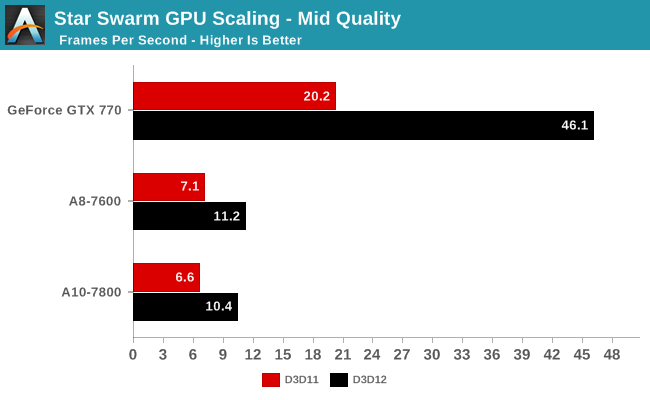

Finally, taking a look at how performance scales with our GPUs, the results are unsurprising but none the less positive for AMD. Aside from the GTX 770 – which has the most GPU headroom to spare in the first place – both AMD APUs still see significant performance gains from DirectX 12 despite running into a very quick GPU bottleneck. This simple API switch is still enough to get another 44% out of the A10-7800 and 25% out of the A8-7600. So although DirectX 12 is not going to bring the same kind of massive performance improvements to iGPUs that we’ve seen with dGPUs, in extreme cases such as this it still can be highly beneficial. And this still comes without some of the potential fringe benefits of the API, such as shifting the TDP balance from CPU to GPU in TDP-constrained mobile devices.
Looking at the overall picture, just as with our initial article it’s important not to read too much into these results right now. Star Swarm is first and foremost a best case scenario and demonstration for the batch submission benefits of DirectX 12. And though games will still benefit from DirectX 12, they are unlikely to benefit quite as greatly as they do here, thanks in part to the much greater share of non-rendering tasks a CPU would be burdened with in a real game (simulation, AI, audio, etc.).
But with that in mind, our results from bottlenecking AMD’s APUs point to a clear conclusion. Thanks to DirectX 12’s greatly improved threading capabilities, the new API can greatly close the gap between Intel and AMD CPUs. At least so long as you’re bottlenecking at batch submission.










152 Comments
View All Comments
akamateau - Tuesday, February 24, 2015 - link
Probably faster ram would be necessary. But who knows. Fully GCN and HSA compatible could make a huge difference. I would really like to see AMD build dual socket APU's!Flunk - Friday, February 13, 2015 - link
I guess we now know why the current-gen consoles all use a lot of low-power CPU cores. With less API overhead, the less-powerful cores makes more sense. This is good for AMD in the short-term at least, because they have poor single thread performance in Bulldozer-derived cores. But it probably means there is even less reason to upgrade your CPU for gaming. It's rare that a software change can yield such big results so let's hope that DirectX 12 becomes popular for all the big blockbuster games, the less taxing ones don't need it anyway.mojobear - Friday, February 13, 2015 - link
Just because DX12 seems to level the playing field for single threaded performance doesn't negative the possibility of better mhz or core scaling. In fact, I read that lower level APIs will likely take greater advantage of mainstream hex and octacore cpus.Flunk - Friday, February 13, 2015 - link
Where are we going to get the GPUs that need those hex and octacore CPUs (which Intel's roadmap lacks in the mainstream even for the next 2 generations). It seems like everything will be GPU-limited, unless game developers come up with something to do with the excess CPU power, like better AI, physics or something I can't even think of right now. It would be great if they did that, but I suspect that the short-term result will be that CPU won't factor into game performance very much.Flunk - Friday, February 13, 2015 - link
Also, I didn't say that DX12 levels the playing field for single-threaded performance, it doesn't. It does however validate AMD's more slower cores policy.mojobear - Friday, February 13, 2015 - link
Based on the batch submission times, it looks like DX12 reduces AMD submission times to the same time as Intel. I thought that speaks to the individual thread performance.FlushedBubblyJock - Sunday, February 15, 2015 - link
If AMD has a more slower cores policy, that right there tells us why they will disappear.I certainly hope you made that up in your head.
HighTech4US - Friday, February 13, 2015 - link
Frame rates of only 10 or 11 on Mid Quality settings for AMD's A8/A10 APUs seem to point out the need for an external discrete GPU and to not use the IGP part of the APU.Even on low settings you only get 20 or 22 FPS from the IGP.
gonchuki - Friday, February 13, 2015 - link
It's not a game, you know? This is a benchmark purposefully built to stress test any CPU+GPU combination. The FPS you see here is just a number, you have to read it as a performance index just like 3DMarks.See how a GTX770 only gets 30FPS at low quality in DX11? has there ever been a real game where running it in low quality yields such performance on a 770? There's your answer.
takeship - Friday, February 13, 2015 - link
I would gently point out that it's quite clear in the graphs that Star Swarm does not stress a 770 significantly, but is crazily CPU limited. Hence the drop between low/medium settings of *only* 4 fps with DX12, and the 70+ fps average with an i3. That said, it appears the bottleneck shifts once you reach medium quality - or star swarm's extreme preset doesn't really up the load significantly.